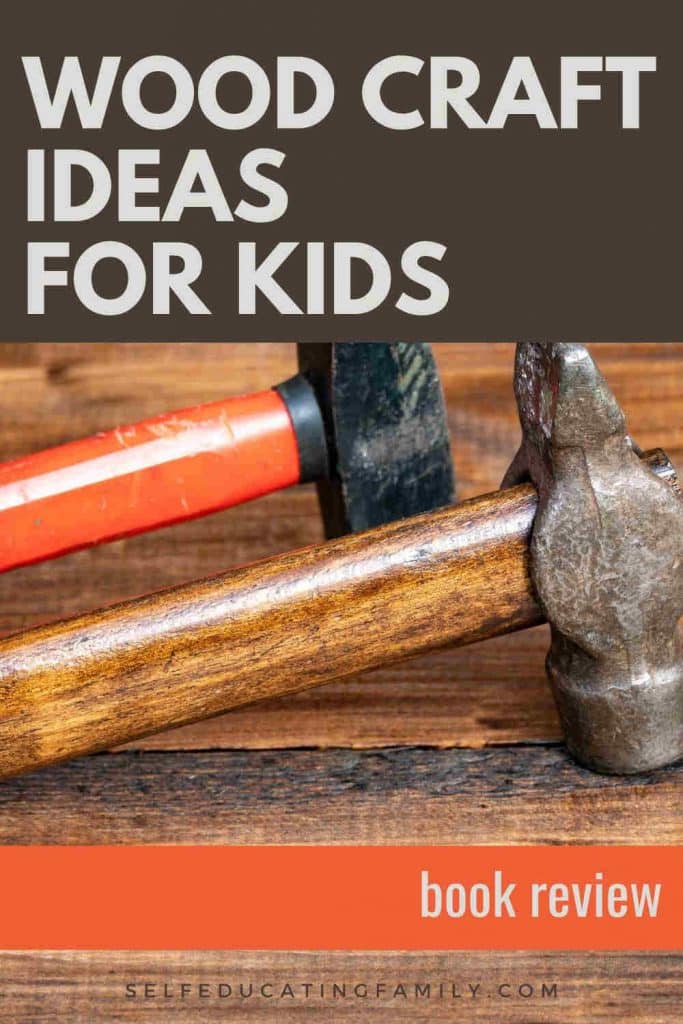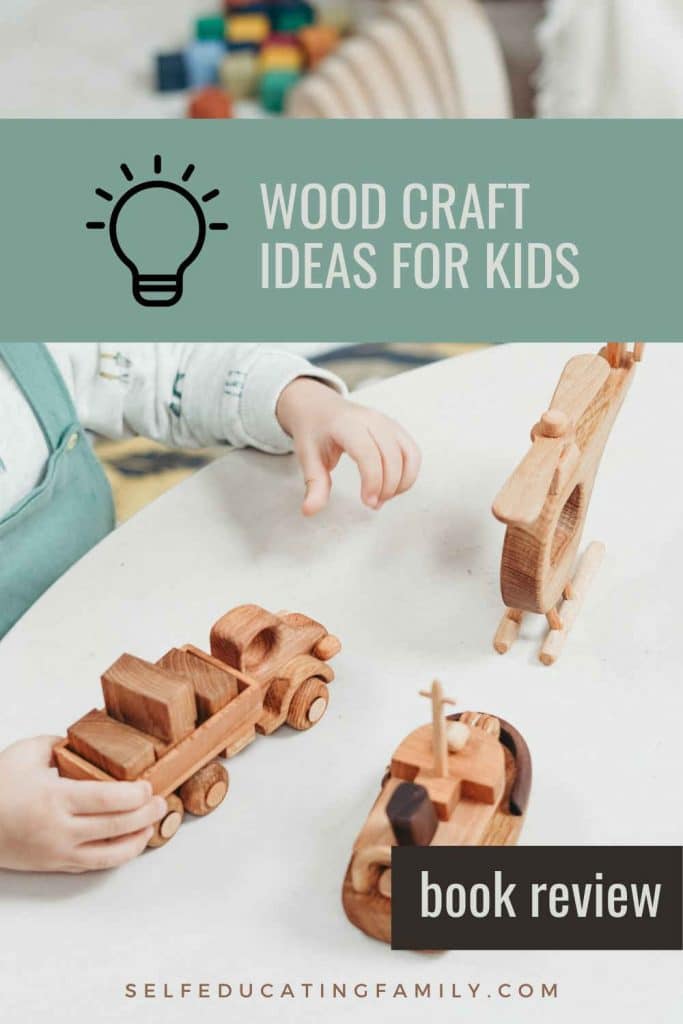What’s inside Wood Craft ideas: Are you unsure about how to teach wood craft to your kids? Here are fantastic ideas from expert by Doug Stowe. We’ll look at how to use his book as a “spine” for the handicraft of wood sloyd. And how to start teaching your kids this valuable life skill.
Wood Craft Ideas from the Guide to Woodworking with Kids
I’m going to reveal fantastic ideas about wood craft based on the “worth-every-penny” book by Doug Stowe called, “The Guide to Woodworking with Kids: Craft Projects to Develop the Lifelong Skills of Young Makers”.
This post is more than a review of the book with some wood craft ideas thrown in – I will also show you how to use this book as a “spine” for the handicraft of wood sloyd. And how to start teaching your kids wood craft.
This post may contain affiliate links. If you find my content valuable and make a purchase through one of my links, I will earn a commission at no cost to you, which helps me keep this blog going so I can help you even more! I recommend products I trust and/or use myself, and all opinions I express are my own. Read the full disclaimer here.
What was Sloyd again?
Sloyd is from the Swedish word slojd and means “handy” or “hand craft”. It’s an educational method used in Sweden that emphasizes the development of the child intellectually and physically. Typical Swedish sloyd materials were wood, metal, and textiles like wool. Charlotte Mason schools turned toward paper and cardboard sloyd after testing other materials.
Does the book deliver?
Yes. Hands-down, yes! I wish this book were written years earlier so I could have used it with my kids, but even someone like me, who has dabbled with wood for 30+ years, learned a ton just from reading it. And I’m confident I will learn more as I begin to work through the lessons myself. Which I want to do!
I wholeheartedly recommend this book.
Spoiler: What’s in the book?
First, the title. I love long titles. Sometimes, they just make me laugh because they are so long and that style is from olden times, like the full title of Robinson Crusoe:
The Life and Strange Surprizing Adventures of Robinson Crusoe, Of York, Mariner: Who lived Eight and Twenty Years, all alone in an un-inhabited Island on the Coast of America, near the Mouth of the Great River of Oroonoque; Having been cast on Shore by Shipwreck, wherein all the Men perished but himself. With An Account how he was at last as strangely deliver’d by Pyrates.
So this title, The Guide to Woodworking with Kids: Craft Projects to Develop the Lifelong Skills of Young Makers, promises to help in several areas dear to my heart:
- Making projects in wood
- Developing Lifelong Skills
- Guiding and training “young makers”
With a title like that, we are in for a treat.
Who is this book for?
Stowe wrote this book for teachers, parents, and grandparents who are working with kids. Sounds like homeschooling parents would fit right in here.
How do I use it for homeschooling?
The book is NOT a curriculum, per se. It does show a progression of wood crafts that kids go through at various stages, but it is aimed at the teacher – how to set up your wood shop to be kid-accessible even starting as young as first graders.
The book covers shop safety thoroughly, so be sure to pay attention to those sections.
Philosophy
Doug Stowe has long used Educational Sloyd in his own teaching at The Wisdom of the Hands Education Program. He bases his philosophy on the works of Friedrich Froebel (inventor of Kindergarten) and Otto Salomon (The Theory of Educational Sloyd).
The Introduction section in this book is essential to our approach. Charlotte Mason also used sloyd principles in handicraft adopted in her schools.
Ideas include:
- Start with the interests of the child. Charlotte Mason’s principle: Children are persons.
- Go from:
- Known to unknown
- Simple to complex
- Concrete to abstract
Lifelong Skills: What benefits can kids get from wood craft?
From the simple idea that a sloyd knife teaches a child how to be responsible with tools – including the care and maintenance of tools, as well as how to use tools safely – a child will develop many skills that build character and will serve them over the course of a lifetime.
On the back of the book, the book promises to “introduce children to woodworking and watch their skills, confidence and creativity thrive.”
Actually, I liked how the book showed examples of how creativity exploded because even the youngest kids had access to scraps of wood and had gained the skills to create an amazing variety of toys.
Other benefits for children which the book asserts include:
- Thinking through problems
- Getting better at inventiveness
- Learning to plan and execute work
- Becoming resourceful and handy at things
- Being able to make meaningful gifts or items for family.
This last item – making useful items – was a huge driving factor in the Swedish Sloyd movement. If a child can see direct results from making things that are helpful for themselves and their family, that will motivate them.
Young Makers
Being able to teach children the practical, lifelong skills that can give meaning to their lives is such a gift. Wood craft is an area that excels at this. Like music or math, there is a wide range of natural abilities for any person. Once young makers have exposure to skills and tools, they just need the opportunity to blossom.
Another comparison to math: Sometimes young people get the idea that “they aren’t good at math” because they were never shown the joy and beauty of working with math. Similarly, if children get a wrong idea about their ability to create, they can carry that with them and it can prevent them from experiencing a richer life.
I’m not saying that everyone will end up with a wood shop in their garage, but you never know where some of these ideas will take them.
One of the keys is to work at their level. For instance, Stowe describes the creation of “platforms” in the lower grades. The kids get access to wood scraps on their “free day” and they can make whatever they want. They glue and decorate various pieces of wood to build everything from dioramas to miniature tree-house-like creations. They collaborate, they work independently – the works. The pictures in this section of the book remind me of recycled craft creations.
How much wood craft do I as the teacher need to know?
This book works for teachers who have some experience in the wood shop.
However, educational sloydists have found that it is easier to teach a teacher how to do wood craft, than it is to teach a carpenter how to teach children.
It is easier to teach a teacher how to do wood craft, than it is to teach a carpenter how to teach children.
Sloyd Principle
The general rule in sloyd schools was that the teacher would have to go through making the models first before she taught the children. And yes, many of the sloyd teachers were women.
The key to the sloyd lessons is individual attention. Children are brought along individually, not always as a group. As Stowe puts it, “I begin a project by describing and demonstrating the process of building something, but what I demonstrate will not become truly clear to my students without first taking time to give personal instruction to each child. That is a lesson from the woodshop that should be accepted and understood in all classes and schools and at all levels and subject areas of instruction.”1
So, really, how much woodcraft do I need?
My answer is, how much do you have now? If you have none, then you will need someone to help you. Or you will need to learn also. If you have someone in your household or extended family who has a wood shop, perhaps you can arrange some lessons. You will need skills to make some of the parts, like wheels, for certain projects or jigs for centering.
If you have no equipment, then you can start with projects that introduce one hand tool at a time and build your skills and your tool box. Or again, team up with someone you know. We did beginning woodcraft as a co-op group handicraft, which worked well for moms who wanted to learn more and for the moms who had help at home, but no time to devote to the craft. We had outside help – some of the dads cut the wood to length for us and the kids (or the moms) did the coping saw curve cuts. The youngest kids did the assembly. The kids worked at their individual levels.
In the past, the Swedish sloyd schools started with the sloyd knife because all children were already familiar with knives and knife safety because of the times they were living in. That may not be the case today.
If you are planning on being the teacher, Stowe talks to parents, grandparents, and teachers who know how to use a table saw, a chop saw, a coping saw, a miter box, and hand tools to prep the lessons and projects.
But he also advises starting small and building your tool box if you are just starting out. Remember the principle of simple to complex. Start simply. Learn each hand tool first, one at a time, and if you need parts cut for you on a table saw to complete a project, you can enlist help if that is above your ability or if you don’t have a table saw!
How much preparation do I need?
1. Make the Bench
If you are experienced, you will want to make the workbench described in the book. It’s a critical component for safety. Or, if you have an older student, you can work on it together, especially if you have younger children also.
The bench has a vise built-in (or two – if you use both ends, Stowe’s bench can accommodate 2 people of similar height. And it’s adjustable for growing children.)
If you don’t have a local favorite woodworking store, the big box stores can sell a basic bench vise for under $25. The Irwin 6-1/2” vise gets good reviews on Amazon. Stowe has you modify the vise when you attach it to the bench to give it bigger stability.
2. Decide what kinds of projects you will make in one semester
By figuring out what ideas for wood craft your kids may be able to do, you define the tools and materials you need, based on what you are capable of teaching and what your kids are capable of doing.
Another example of how to adjust if you are learning too: you don’t have to cut your own wheels yet – you can purchase some already made. That opens up making cars and toys.
Watch for Part 2
This post is so long that I’m cutting it off here. Watch for the next installment – It should talk about how to select projects for a semester.
FAQ
- What crafts can you make from wood?
- You can always find ideas for small wood home décor projects on the internet. Remember that sloyd is supposed to use models that are useful around the house. Small projects include wooden toys, coasters, picture frames, cutting boards. Larger projects include caddies (like magazine holders), raised garden beds, coffee tables or coat racks.
- What can I make out of Wood for beginners?
- You’d be surprised what beginner woodworkers can make. We made flower presses and garden boxes with our mixed-age group. In his book, Stowe describes box-making done by very young learners.
- What can I make out of wood as a gift?
- Gift-making is totally in line with Charlotte Mason’s methods. Handicraft is supposed to be useful. While the emphasis is on developing the child rather than the output of the handicraft, it is not unusual for the output to be gifted to someone once a child has mastered a method. Toys and household items can make lovely gifts.

Keep Learning
Articles
More
- Doug Stowe: The Guide to Woodworking with Kids
- Wood projects that sell (I’m not saying you want to sell items, but the lists like this typically have useful items for some great ideas – like #5 The Box Shelves)
- Woodworking Projects to sell
- 100 Wood Projects for beginners
- Easy beginner woodworking projects
1Stowe, Douglas: The Guide to Woodworking with Kids, page 11.

